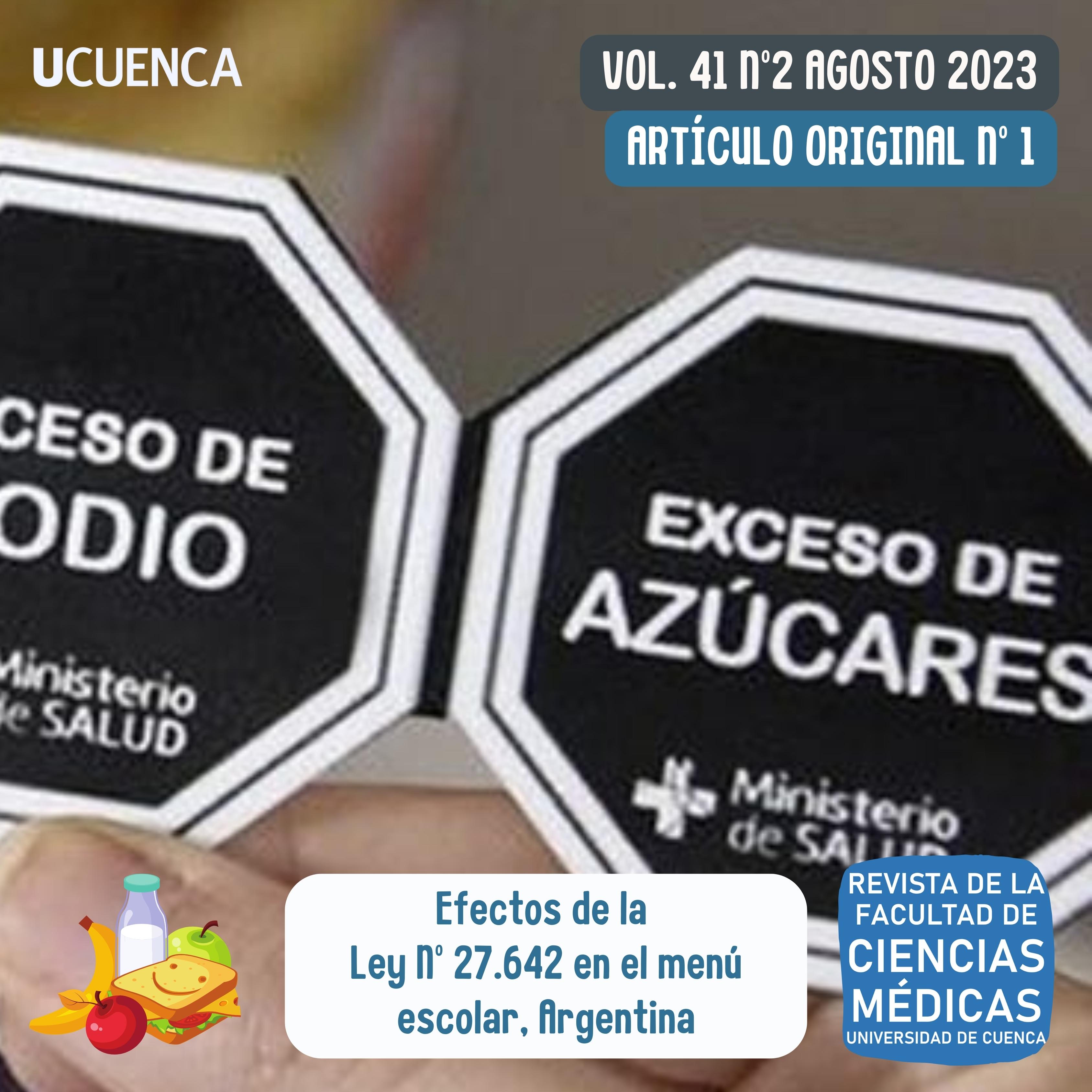Efectos de la Ley N° 27.642 en el menú escolar, Argentina
DOI:
https://doi.org/10.18537/RFCM.41.02.02Palabras clave:
Argentina, alimentación escolar, etiquetado de alimentosResumen
Introducción: en Argentina los escolares se alimentan con programas estatales, en el año 2021 se dicta una ley que promueve la mejora del menú en cada centro educativo, una realidad que merece ser estudiada por las implicaciones en la seguridad alimentaria y el rendimiento académico.
Objetivo: analizar el efecto de la Ley N° 27.642 de “Promoción de la Alimentación Saludable” en la oferta de desayuno o merienda escolar en las provincias participantes de Argentina en el 2022.
Metodología: estudio observacional descriptivo; la población incluyó a todas las jurisdicciones del país, participando de la muestra 9 provincias, cuyas listas de menú de desayuno y merienda aportaron 276 alimentos. Se determinó la composición nutricional y la presencia de sellos y mensajes de advertencia regidos por la ley; se categorizaron los alimentos según las Guías Alimentarias para la Población Argentina (GAPA).
Resultados: se encontró que 102 alimentos (37% del total) alimentos serían alcanzados por la nueva normativa, de los cuales 95 productos llevarían al menos un sello por exceso de nutrientes críticos en la primera etapa de aplicación, siendo el sello más frecuente el exceso de azúcares (73%). En la segunda etapa, la totalidad de los alimentos alcanzados llevarían al menos un sello de exceso de nutrientes críticos, siendo los predominantes el exceso de azúcares (82%) y de calorías (81%). En ninguna etapa se hallaron productos que requieran la declaración de leyendas precautorias. Al categorizar los alimentos alcanzados por la normativa según las GAPA, el 88,2% correspondió al grupo de alimentos de consumo opcional, el 9,8% al grupo de leche, yogur y quesos, el 1% al grupo de cereales, legumbres, pan y pastas y el 1% al grupo de frutas y verduras.
Conclusiones: el efecto de la Ley Nº 27.642 encontró que 95 de 276 alimentos tienen exceso de azúcares, en la segunda fase predominaron en alto porcentaje el exceso de azúcares y calorías; no se necesitó declaración de leyendas precautorias.
Descargas

Publicado
Número
Sección
Licencia
Derechos de autor 2023 Daniela Gómez Jaramillo, María Celeste Nessier Villaverde, Paula Virginia Gómez Dieste, Alicia Beatriz Rovirosa Sánchez

Esta obra está bajo una licencia internacional Creative Commons Atribución-NoComercial-CompartirIgual 4.0.
Copyright © Autors

Usted es libre de:
 |
Compartir — compartir y redistribuir el material publicado en cualquier medio o formato. |
 |
Adaptar — combinar, transformar y construir sobre el material para cualquier propósito, incluso comercialmente. |
Bajo las siguientes condiciones:
 |
Atribución — Debe otorgar el crédito correspondiente, proporcionar un enlace a la licencia e indicar si se realizaron cambios. Puede hacerlo de cualquier manera razonable, pero de ninguna manera que sugiera que el licenciador lo respalda a usted o a su uso. |
| No comercial — No puede utilizar el material con fines comerciales. | |
| Compartir Igual— si remezcla, transforma o desarrolla el material, debe distribuir sus contribuciones bajo la misma licencia que el original. |
| Sin restricciones adicionales: no puede aplicar términos legales o medidas tecnológicas que restrinjan legalmente a otros a hacer cualquier cosa que permita la licencia. |





